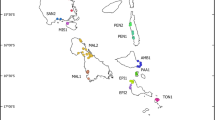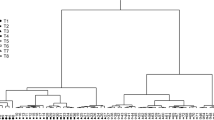Abstract
As part of a wider study characterizing tree-to-tree variation in fruit traits as a pre-requisite for cultivar development, fruits were collected from each of 63 marula (Sclerocarya birrea) trees in Bushbuckridge, South Africa and from 55 trees from the North Central Region of Namibia. The nuts were removed from the fruit flesh, and the kernels extracted, counted and weighed individually to determine the patterns of dry matter partitioning among the nut components (shell and kernel) of different trees. Mean nut, shell and kernel mass were not significantly different between the two countries. Between sites in South Africa there were highly significant differences in mean nut mass, shell mass, kernel mass and kernel number. In Namibia, there were highly significant differences between geographic areas in mean shell mass, kernel mass and kernel number, but not in nut mass. These differences had considerable impacts on shell:kernel ratios (8.0 - 15.4). In South Africa, mean kernel mass was significantly greater in fruits from farmers fields (0.42 g) than from communal land (0.30 g) or natural woodland (0.32 g). Within all sites, in both South Africa and Namibia, there was highly significant and continuous variation between individual trees in nut mass (South Africa = 2.3 - 7.1 g; Namibia = 2.7 - 6.4 g) and kernel mass (South Africa = 0.09 - 0.55 g; Namibia = 0.01 - 0.92 g). The small and valuable kernels constitute a small part of the nut (Namibia = 6.1- 11.1%; South Africa = 7.6 - 10.7%). There can be 4 kernels per nut, but even within the fruits of the same tree, kernel number can vary between 0-4, suggesting variation in pollination success, in addition to genetic variation. The nuts and kernels of the Namibian trees were compared with the fruits from one superior tree (Namibian Wonder: nuts = 10.9 g; kernels = 1.1 g). Oil content (%) and oil yield (g/fruit) also differed significantly between trees (44.7 - 72.3% and 8.0 - 53.0 g/fruit). The percentage frequency distribution of kernel mass was skewed from trees in farmers fields in South Africa and in some sites in Namibia, suggesting a level of anthropogenic selection. It is concluded that there is great potential for the development of cultivars for kernel traits, but there is also a need to determine how to increase the proportion of nuts with four kernels, perhaps through improved pollination success.
Similar content being viewed by others
References
P.O. Anegbeh C. Usoro V. Ukafor Z. Tchoundjeu R.R.B. Leakey K. Schreckenberg (2003) ArticleTitleDomestication of Irvingia gabonensis: 3. Phenotypic variation of fruits and kernels in Nigeria Agroforestry Systems 58 213–218 Occurrence Handle10.1023/A:1026094021408
A.R. Atangana Z. Tchoundjeu J.-M. Fondoun E. Asaah M. Ndoumbe R.R.B. Leakey (2001) ArticleTitleDomestication of Irvingia gabonensis: 1. Phenotypic variation in fruit and kernels in two populations from Cameroon Agroforestry Systems 53 55–64 Occurrence Handle10.1023/A:1012293700774
A.R. Atangana V. Ukafor P.O. Anegbeh E. Asaah Z. Tchoundjeu C. Usoro J-M. Fondoun M. Ndoumbe R.R.B. Leakey (2002) ArticleTitleDomestication of Irvingia gabonensis: 2. The selection of multiple traits for potential cultivars from Cameroon and Nigeria Agroforestry Systems 55 221–229 Occurrence Handle10.1023/A:1020584823505
A.E.C. Burger J.B.M. Villers Particlede L.M. du Plessis (1987) ArticleTitleComposition of the kernel oil and protein of the marula seed South African Journal of Science 83 733–735 Occurrence Handle1:CAS:528:DyaL1cXltV2is78%3D
R.R.B. Leakey (1999a) Agroforestry for biodiversity in farming systems W.W. Collins C.O. Qualset (Eds) Biodiversity in Agroecosystems. CRC Press New York ,USA 127–145
R.R.B. Leakey (1999b) ArticleTitlePotential for novel food products from agroforestry trees: A review Food Chemistry 66 1–14 Occurrence Handle10.1016/S0308-8146(98)00072-7 Occurrence Handle1:CAS:528:DyaK1MXislGqtb4%3D
R.R.B. Leakey (2001) ArticleTitleWin:Win landuse strategies for Africa: 2. Capturing economic and environmental benefits with multistrata agroforests International Forestry Review 3 11–18
R.R.B. Leakey (2005) ArticleTitleDomestication potential of Marula (Sclerocarya birrea subsp. caffia) in South Africa and Namibia: 3 Multiple trait selection Agroforesty Systems 64 51–59
R.R.B. Leakey A.J. Simons (1998) ArticleTitleThe domestication and commercialisation of indigenous trees in agroforestry for the alleviation of poverty Agroforestry Systems 38 165–176
R.R.B. Leakey M Fondoun J- A. Atangana Z. Tchoundjeu (2000) ArticleTitleQuantitative descriptors for variation in the fruit and seeds of Irvingia gabonensis Agroforestry Systems 50 47–58 Occurrence Handle10.1023/A:1006434902691
R.R.B. Leakey Z. Tchoundjeu R.I. Smith R.C. Munro J.-M. Fondoun J. Kengue P.O. Anegbeh A.R. Atangana A.N. Waruhiu E. Asaah C. Usoro V. Ukafor (2004a) ArticleTitleEvidence that subsis- 48 tence farmers have domesticated indigenous fruits (Dacryodes edulis and Irvingia gabonensis) in Cameroon and Nigeria Agroforestry Systems 60 101–111 Occurrence Handle10.1023/B:AGFO.0000013259.95628.22
R.R.B. Leakey S. Shackleton P. du Plessis (2005) ArticleTitleDomestication potential of Marula (Sclerocarya birrea subsp caffra) in South Africa and Namibia: 1. Phenotypic variation in fruit traits Agroforestry Systems 64 25–35
Mander M., Cribbins J.and Lewis F. 2002. The commercial marula industry: a sub-sector analysis. Report to UK DFID Forestry Research Programme (Project No R7795). Institute of Natural Resources, Scottsville, South Africa, 79 pp.
E. Nghitoolwa J.B. Hall F.L. Sinclair (2003) ArticleTitlePopulation status and gender imbalance of the marula tree, Sclerocarya birrea subsp. caffra, in northern Namibia Agroforestry Systems 59 289–294 Occurrence Handle10.1023/B:AGFO.0000005229.73175.07
C. Poulton N. Poole (2001) Poverty and fruit tree research, DFID Issues and Options Paper, Forestry research Programme Imperial College at Wye Kent, England
Shackleton S.E. 2002. The informal marula beer traders of Bushbuckridge, Limpopo Province, South Africa. Report to UK DFID Forestry Research Programme (Project No R7795), Rhodes University, Grahamstown, South Africa, 25 pp.
S.E. Shackleton C.M. Shackleton A.B. Cunningham C. Lombard C.A. Sullivan T.R. Netshiluvhi (2002a) ArticleTitleKnowledge on Sclerocarya birrea subsp. caffra with emphasis on its importance as a non-timber forest product in South and southern Africa: A summary, Part 1: Taxonomy, ecology and role in rural livelihoods Southern African Forestry Journal 194 27–41
Shackleton C.M., Botha J, Emanuel P.L. and Ndlovu S. 2002b. Inventory of marula (Sclerocarya birrea subsp. caffra) stocks and fruit yields in communal and protected areas of the Bushbuckridge lowveld, Limpopo Province, South Africa. Report to UK DFID Forestry Research Programme (Project No R7795), Rhodes University, Grahamstown, South Africa, 17 pp.
Simons A.J. and Leakey R.R.B. in press. Tree domestication in tropical agroforestry. Agroforestry Systems 0: 000-000.
Sullivan C.A., O’Regan D.P., Shackleton S., Ousman S., Shackleton C., Mander M., Wynberg R., den Adel S., Leakey R.R.B, Cunningham A.B., Botelle A., Combrinck A., Datadin V., Forte J., Hammond D., Laird S., Lombard C., Martinborough T., McHardy T., Muller J., Netshiluvhi T., Payne K., du Plessis P. Poulsen U., Radzik V., Both J., Cribbins J., Emmanuel P., Grimmond J., Joseph I., Laamanen R., Lewis F., Ndlovu S., Pate K., Strong J. and Thomas R. 2003. Winners and Losers in Forest Product Commercialisation, Final Report to DFID Forestry Research Programme (R7795), Centre for Ecology and Hydrology, Wallingford, UK, CD and www.ceh-wallingford.ac.uk/research/ winners/literature.html.
M.K. Thiong’o S. Kingori H. Jaenicke (2002) ArticleTitleThe taste of the wild: Variation in the nutritional quality of marula fruits and opportunities for domestication Acta Horticulturae 575 237–244
R. Wynberg J. Cribbins R.R.B. Leakey C. Lombard M. Mander S.E. Shackleton C.A. Sullivan (2002) ArticleTitleKnowledge on Sclerocarya birrea subsp. caffra with emphasis on its importance as a non-timber forest product in South and southern Africa: A summary. 2. Commercial use, tenure and policy, domestication, intellectual property rights and benefit-sharing Southern African Forestry Journal 196 67–77
Author information
Authors and Affiliations
Corresponding author
Rights and permissions
About this article
Cite this article
Leakey, R., Pate, K. & Lombard, C. Domestication potential of Marula (Sclerocarya birrea subsp caffra) in South Africa and Namibia: 2. Phenotypic variation in nut and kernel traits. Agroforest Syst 64, 37–49 (2005). https://doi.org/10.1007/s10457-005-2420-6
Received:
Accepted:
Issue Date:
DOI: https://doi.org/10.1007/s10457-005-2420-6




